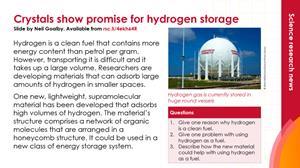Lightweight supramolecular material shows promise for hydrogen-powered vehicles
-

Download this
Use this story and the accompanying summary slide for a real-world context when studying hydrogen fuel cells with your 14–16 learners.
Download the story as MS Word or PDF and the summary slide as MS PowerPoint or PDF.
An international team of chemists has developed a new class of lightweight materials that can cram lots of hydrogen into their pores. The materials are networks of organic molecules and one of them has a storage ability and weight that beats the US Department of Energy (DoE) targets for use in hydrogen fuel cell-powered vehicles, albeit only at very cold temperatures.
Hydrogen is often touted as an important clean fuel of the future, but transporting useful quantities of it poses a major challenge. Hydrogen takes up a lot more space than petrol, meaning we need unfeasibly large fuel tanks to achieve an acceptable driving range. To overcome this issue, researchers are designing materials able to hold large amounts of hydrogen in small spaces. The DoE has set the target of being able to store over 50 grams of hydrogen per litre of the material, and has stated that the storage material itself should not be too heavy. Meeting both of these requirements has proven difficult.
Crystal design
Now, a team of chemists, including 2016 chemistry Nobel laureate Fraser Stoddart, has made a porous crystal that meets both DoE requirements. The lightweight crystal comprises a honeycomb network of interlinked organic molecules. It is the interlinking that gives the material its stability. Fraser and his team showed that the crystal can store 53 grams of hydrogen per litre of the crystal.
There is a catch, however. The material requires cryogenic cooling to perform at its best, which is impractical in hydrogen-powered vehicles. In a journal paper announcing these findings, the chemists said that they hope optimising the crystal design will lead them to a material that works at higher temperatures, making it suitable for hydrogen cars.
This article is adapted from Jamie Durrani’s in Chemistry World.
Nina Notman
Reference
R Zhang et al, Nat. Chem., 2024, doi.org/10.1038/s41557-024-01622-w
Download this
Summary slide with questions and the article for context when teaching 14–16 lessons on hydrogen fuel cells: rsc.li/WHEELBARROW
Downloads
Crystals show promise for hydrogen storage student sheet
Handout | PDF, Size 0.2 mbCrystals show promise for hydrogen storage student sheet
Handout | Word, Size 0.82 mbCrystals show promise for hydrogen storage summary slide
Presentation | PDF, Size 0.33 mbCrystals show promise for hydrogen storage summary slide
Presentation | PowerPoint, Size 1.43 mb














No comments yet